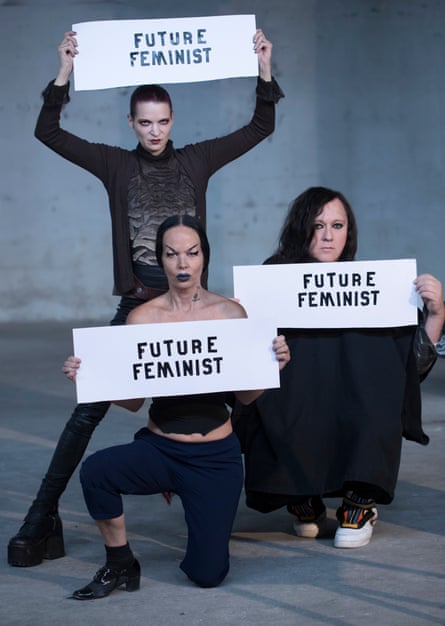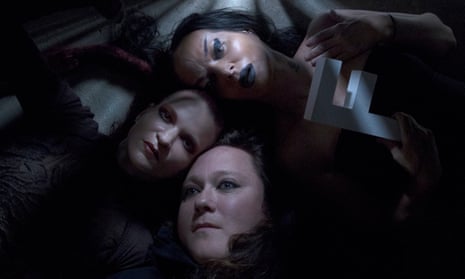In February, in her first speech after the inauguration of Trump, Hillary Clinton made the declaration that “despite all the challenges you face, I remain convinced that yes, the future is female”.
It was a bittersweet moment for Anohni, the musician and artist who formerly performed as the Mercury prize-winning Antony and the Johnsons. Three years earlier she, and four fellow artists, used the phrase “the future is female” as a central tenet of their Future Feminism manifesto, even carving it into stone for a controversial exhibition in New York that year.
“She’s totally misrepresented and appropriated our work, but that’s how culture works now,” says Anohni on Clinton’s use of “the future is female” as a headline-grabbing talking point. Some have pointed out the phrase has been before, as a T-shirt slogan in the 1970s that was later reused by Cara Delevingne and others; Anohni insists they came up with it organically. “Our work was stolen and upstreamed, and here it is, coming out of the mouth of Hillary Clinton, who is just capitalising on a woman’s movement to get support for her neo-liberal agenda. The empowerment is brilliant, but the connectivity is lost.”
Yet, as she replays the clip of Clinton again and again, Anohni also looks pleased that the work of “five scruffy artists” has found its way into popular political rhetoric. “I watch it 10 times a day,” she says with a wry smile.
Having made its divisive debut at The Hole gallery in New York in 2014, Anohni and artists Johanna Constantine and Kembra Pfahler, who all met in the fringe New York art scene in the 90s, are debuting Future Feminism in Europe , as part of the European Capital of Culture programme in Aarhus, Denmark.

She has never shied away from political issues, with subjects on her most recent album (which won her both Mercury and Brit award nominations) including drone warfare, Guantánamo Bay, surveillance, torture and ecological destruction. Anohni resists Future Feminism being described as a movement, but its manifesto, and the exhibition, is focused around 13 tenets which take on misogyny and the patriarchal systems that govern the world.
“Those powers are much more comfortable with women complaining about abortion; black people protesting about violence against black children and black men on the streets; gay people fussing; trans people fussing,” she says. “They are much more comfortable with us all being divided and conquered, and no one talking about the money – and it’s the money that is the bottom line.”
The tenets, carved on large spheres of rose quartz, include “Enforce a global standard for the rights and ethical treatment of women”; “Advocate for feminine systems in all areas of governance”; “Relieve men of their roles as protectors and predators”; and “Deconstruct the mythology of male spiritual supremacy”.
It is time, they argue, that feminine values such as empathy and compassion – which have long been seen as weaknesses, and impediments to power – take precedence in our society, not only to ensure the ethical treatment of women but also to stop the imminent collapse of the earth’s bioversity due to climate change. As the first tenet of Future Feminism states: “The subjugation of women and the earth is one and the same.”

Anohni, who has identified as transgender since childhood and was previously known as Antony Hegarty, has spoken about how her involvement in Future Feminism was a key part of her decision to identify as “she” rather than “he”. Indeed, she is scathing about the current trend towards embracing a non-gender binary world, where neither masculinity or femininity is acknowledged or valued.
“This whole fantasy of this gender neutral oasis in the middle between the genders has been incredibly disempowering,” she said. “They’ve exchanged the female creative hub of life with this secular gender-neutral lump that we are all staring at and don’t have a relationship to.”
The world is a very different place from three years ago when they first introduced Future Feminism to the world, but Anohni is dubious that recent events – such as the global women’s marches, the rise of women in positions of political influence and the renewed conversation around feminism that is happening in popular culture – have really changed anything. The reverence of masculine values remains unchanged, she argues, and women continue to be oppressed while the temperature of our planet continues to rise.
“We weren’t a knee-jerk response to an inflammatory provocation like Trump, which is in my mind just as much of a distraction from the core issues as it is a genuine call to arms,” she says. “It’s amazing how we leap into action like lemmings when Trump screams about grabbing a pussy. But actually all the machinations that led to the rise of someone like Trump were very much in place already during the Obama administration.”
Both Pfahler and Constantine nodded. “It almost feels like they just keep tossing us a bone so we shut up and let them continue with business as usual,” said Constantine. “So as exciting as it is to see feminism springing up, I still look at it as a veil over their misogyny and if you pull off that veil, there’s still the same corrupt, rotten, toxic systems under it. It’s not enough, so this exhibition feels just as important to me, just as critical to me, even more so, in light of what’s happening now.”
Pfahler took an even more cynical view of the way that the recent resurgence of feminism had already been appropriated. “You can see a lot of the capitalist tables are now sitting around thinking: ‘What can we do to monetise feminism? Everyone’s talking about feminism, why don’t we make a Margaret Atwood TV show?’”
Anohni and her fellow artists were criticised by feminist groups and artists in 2014 when they first launched their manifesto, for seeing themselves as the “future of feminism”, something Anohni said was never their intention. They have no set agenda about how they will instigate the changes they are advocating, but believe that through this high-profile exhibition, the ideas of Future Feminism will move from the fringes and into people’s homes and spheres of influence; as well as the quartz sculptures, the exhibition features talks with guests such as radical feminist group FEMEN and the founding member of the Swedish Feminist Party. The trio are also adamant that men are as central to their vision as women, and that it is essential that men adopt and promote feminine values as much as women.
While they cite Clinton as evidence that the ethos of Future Feminism can trickle out beyond the underground art scene, none are optimistic that anything is changing. In fact, as punk and alternative performance artists in their 40s and 50s – whose fate was to “make extreme artwork, don’t talk to anyone and then die young in some dramatic, high fashion way” – they all agreed it was a miracle they were even still alive.
“Can we make a difference? I don’t know,” says Anohni. “You see what I am, you see what we are. We’re not groomed for this; we were groomed to die.”

Comments (…)
Sign in or create your Guardian account to join the discussion